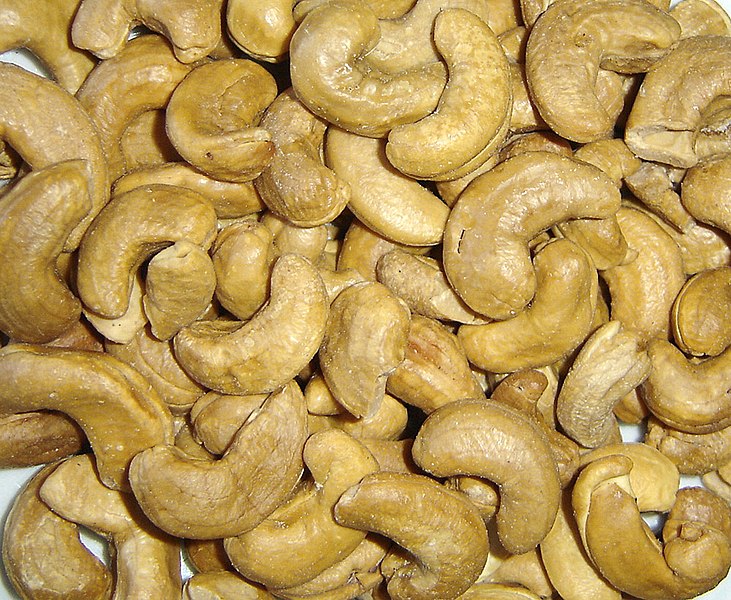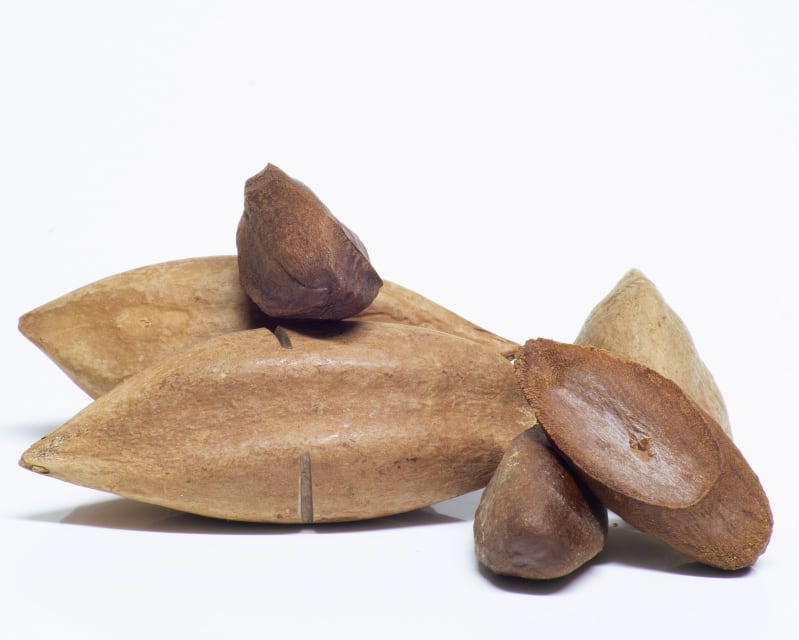Cashews vs. Pili Nut
Nutrition comparison of Cashews and Pili Nut
Ever wonder how your favorite foods stack up against each other in terms of nutrition?
We compared the nutritional contents of
cashews
versus
pili nut
(100g each)
below using 2020 USDA and NIH data[1].
For a quick recap of significant nutrients and differences in cashews and pili nut:
- Both cashews and pili nut are high in calories, iron, potassium, protein and saturated fat.
- Cashew is an excellent source of dietary fiber.
- Pili nut has more thiamin and folate, however, cashew contains more Vitamin B6.
- Pili nut is an excellent source of calcium.
USDA sources for nutritional information: Cashews (Nuts, cashew nuts, raw) and Pili Nut (Nuts, pilinuts, dried) . Have a correction or suggestions? Shoot us an email.
Calories and Carbs
calories
Both cashews and pili nut are high in calories. Pili nut has 30% more calories than cashew - cashew has 553 calories per 100 grams and pili nut has 719 calories.
For macronutrient ratios, cashews is heavier in protein, heavier in carbs and much lighter in fat compared to pili nut per calorie. Cashews has a macronutrient ratio of 12:21:67 and for pili nut, 6:2:92 for protein, carbohydrates and fat from calories.
Macro Ratios from Calories:
| Cashews | Pili Nut | |
|---|---|---|
| Protein | 12% | 6% |
| Carbohydrates | 21% | 2% |
| Fat | 67% | 92% |
| Alcohol | ~ | ~ |
carbohydrates
Cashew is high in carbohydrates and pili nut has 87% less carbohydrates than cashew - cashew has 30.2g of total carbs per 100 grams and pili nut has 4g of carbohydrates.
dietary fiber
Cashew is an excellent source of dietary fiber and it has more dietary fiber than pili nut - cashew has 3.3g of dietary fiber per 100 grams and pili nut does not contain significant amounts.
sugar
Pili nut has less sugar than cashew - cashew has 5.9g of sugar per 100 grams and pili nut does not contain significant amounts.
Protein
protein
Both cashews and pili nut are high in protein. Cashew has 69% more protein than pili nut - cashew has 18.2g of protein per 100 grams and pili nut has 10.8g of protein.
Fat
saturated fat
Both cashews and pili nut are high in saturated fat. Pili nut has 301% more saturated fat than cashew - cashew has 7.8g of saturated fat per 100 grams and pili nut has 31.2g of saturated fat.
Vitamins
Vitamin C
Cashews and pili nut contain similar amounts of Vitamin C - cashew has 0.5mg of Vitamin C per 100 grams and pili nut has 0.6mg of Vitamin C.
Vitamin A
Pili nut and cashews contain similar amounts of Vitamin A - pili nut has 2ug of Vitamin A per 100 grams and cashew does not contain significant amounts.
Vitamin E
Cashew has more Vitamin E than pili nut - cashew has 0.9mg of Vitamin E per 100 grams and pili nut does not contain significant amounts.
Vitamin K
Cashew has more Vitamin K than pili nut - cashew has 34.1ug of Vitamin K per 100 grams and pili nut does not contain significant amounts.
The B Vitamins
Pili nut has more thiamin and folate, however, cashew contains more Vitamin B6. Both cashews and pili nut contain significant amounts of riboflavin, niacin and pantothenic acid.
| Cashews | Pili Nut | |
|---|---|---|
| Thiamin | 0.423 MG | 0.913 MG |
| Riboflavin | 0.058 MG | 0.093 MG |
| Niacin | 1.062 MG | 0.519 MG |
| Pantothenic acid | 0.864 MG | 0.479 MG |
| Vitamin B6 | 0.417 MG | 0.115 MG |
| Folate | 25 UG | 60 UG |
Minerals
calcium
Pili nut is an excellent source of calcium and it has 292% more calcium than cashew - cashew has 37mg of calcium per 100 grams and pili nut has 145mg of calcium.
iron
Both cashews and pili nut are high in iron. Cashew has 89% more iron than pili nut - cashew has 6.7mg of iron per 100 grams and pili nut has 3.5mg of iron.
potassium
Both cashews and pili nut are high in potassium. Cashew has 30% more potassium than pili nut - cashew has 660mg of potassium per 100 grams and pili nut has 507mg of potassium.
Omega-3 and Omega-6
omega 6s
Comparing omega-6 fatty acids, both cashews and pili nut contain significant amounts of linoleic acid.
| Cashews | Pili Nut | |
|---|---|---|
| other omega 6 | 0.266 G | ~ |
| linoleic acid | 7.782 G | 7.605 G |
| Total | 8.048 G | 7.605 G |
Customize your serving size
The comparison below is by weight, but sometimes 100g isn't that intuitive of a measurement for food. View a custom portion comparison (e.g. cups, oz, package).
You can try adding or subtracting the amount of either Cashews or Pili Nut .
Cashews g
()
|
Daily Values (%) |
Pili Nut g
()
|
|||||
|---|---|---|---|---|---|---|---|
| KCAL % |
|
5% | calories | 5% |
|
KCAL % | |
| G % |
|
5% | carbohydrates | 5% |
|
G % | |
| G % |
|
5% | dietary fiber | 5% |
|
G % | |
| G | 5% | sugar | 5% | G | |||
| G % |
|
5% | total fat | 5% |
|
G % | |
| G % |
|
5% | saturated fat | 5% |
|
G % | |
| G | 5% | monounsaturated fat | 5% | G | |||
| G | 5% | polyunsaturated fat | 5% | G | |||
| G | 5% | trans fat | 5% | G | |||
| MG | 5% | cholesterol | 5% | MG | |||
| MG % |
|
5% | sodium | 5% |
|
MG % | |
| 5% | Vitamins and Minerals | 5% | |||||
| UG % |
|
5% | Vitamin A | 5% |
|
UG % | |
| MG % |
|
5% | Vitamin C | 5% |
|
MG % | |
| IU % |
|
5% | Vitamin D | 5% |
|
IU % | |
| MG % |
|
5% | calcium | 5% |
|
MG % | |
| MG % |
|
5% | iron | 5% |
|
MG % | |
| MG % |
|
5% | magnesium | 5% |
|
MG % | |
| MG % |
|
5% | potassium | 5% |
|
MG % | |
| MG % |
|
5% | thiamin (Vit B1) | 5% |
|
MG % | |
| MG % |
|
5% | riboflavin (Vit B2) | 5% |
|
MG % | |
| MG % |
|
5% | niacin (Vit B3) | 5% |
|
MG % | |
| MG % |
|
5% | Vitamin B6 | 5% |
|
MG % | |
| MG % |
|
5% | pantothenic acid (Vit B5) | 5% |
|
MG % | |
| UG % |
|
5% | folate (Vit B9) | 5% |
|
UG % | |
| UG % |
|
5% | Vitamin B12 | 5% |
|
UG % | |
| MG % |
|
5% | Vitamin E | 5% |
|
MG % | |
| UG % |
|
5% | Vitamin K | 5% |
|
UG % | |
| G % |
|
5% | protein | 5% |
|
G % | |
| UG % |
|
5% | biotin (Vit B7) | 5% |
|
UG % | |
| MG % |
|
5% | choline | 5% |
|
MG % | |
| MG % |
|
5% | chlorine | 5% |
|
MG % | |
| UG % |
|
5% | chromium | 5% |
|
UG % | |
| MG % |
|
5% | copper | 5% |
|
MG % | |
| UG % |
|
5% | fluoride | 5% |
|
UG % | |
| UG % |
|
5% | iodine | 5% |
|
UG % | |
| MG % |
|
5% | manganese | 5% |
|
MG % | |
| UG % |
|
5% | molybdenum | 5% |
|
UG % | |
| MG % |
|
5% | phosphorus | 5% |
|
MG % | |
| UG % |
|
5% | selenium | 5% |
|
UG % | |
| MG % |
|
5% | zinc | 5% |
|
MG % | |
| G | 5% | Water | 5% | G | |||
| G | 5% | Starch | 5% | G | |||
| G | 5% | Alcohol | 5% | G | |||
FAQ
Does cashews or pili nut contain more calories in 100 grams?Both cashews and pili nut are high in calories. Pili nut has 30% more calories than cashew - cashew has 553 calories in 100g and pili nut has 719 calories.
Does cashews or pili nut contain more calcium?
Pili nut is a rich source of calcium and it has 290% more calcium than cashew - cashew has 37mg of calcium in 100 grams and pili nut has 145mg of calcium.
Does cashews or pili nut contain more iron?
Both cashews and pili nut are high in iron. Cashew has 90% more iron than pili nut - cashew has 6.7mg of iron in 100 grams and pili nut has 3.5mg of iron.
Does cashews or pili nut contain more potassium?
Both cashews and pili nut are high in potassium. Cashew has 30% more potassium than pili nut - cashew has 660mg of potassium in 100 grams and pili nut has 507mg of potassium.

